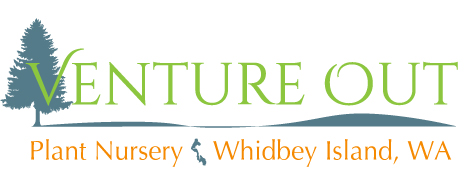Conifers for Whidbey Island Gardens
Gardening on Whidbey Island can sometimes be tricky! We are not without our host of challenges: wind, deer, rabbits, and poor soil are just a few of the obstacles many gardeners face. Tough conditions require tough plants, and frequently a Conifer is the answer!
Conifers are cone-bearing plants. They are typically (but not always!) evergreen. Their foliage offers great texture, and many offer excellent color as well as year-round interest for the garden. Many of us are familiar with Firs, Hemlock, and Cedar. Since they are native to our area, they are common and well adapted to many Island gardens. But there are many other types of Conifers that offer interesting and alternative choices. From low-growing groundcovers to shrubs to towering trees, here are a few of my favorites.

Pine (Pinus)
These plants offer great choices for a beachside garden. If you garden with wind, strong sun, and droughty sandy soils, you might want to consider a Pine. They are also deer- and rabbit-resistant. (A clear bonus!) A Mugo Pine is a great choice for a shrubby shape. A striking and strong Japanese Black Pine is great if you’d like a real centerpiece – maybe P. thunbergiana ‘Thunderhead’. If blue is a color you love in your garden, you might like a ‘Vanderwolf’s Pyramid’ Limber Pine for a soft blue backdrop, with a Pinus parviflora glauca as a specimen. Of course, there are lots of others to choose from, but these are my favorite Pines.
Juniper (Juniperus)
As a young city gardener, I discounted Junipers. I thought of them just as scratchy things that smelled like the cat box. After over 14 years gardening on Whidbey, I have come to appreciate this genus. Deer and rabbits leave them alone. They take wind, drought, and terrible soil without missing a beat – they actually seem to thrive on neglect! I have several Juniper varieties in my garden. I use Wichita Blue and Moonglow for their strong columnar structure, and I love my ‘Grey Owl’ for its horizontal shape and excellent steely blue color. ‘Daub’s Frosted’ is the next one I will plant – the two-toned gold and blue foliage makes it a stunning low groundcover.
Cypress & False Cypress (Chamaecyparis) & Japanese Cedar (Cryptomeria)
If you have a hard time loving Conifers because you think they are scratchy and needle-y, then take a look at the plants in this genus. There are many “pet-able” plant pals to meet! This is also a great group for foliage color! From Cryptomeria japonica ‘Spiralis’, a rounded shrub also known as “Granny’s Ringlets” for its lime-green, curly lock-like foliage, to Chamaecyparis ‘Blue Feathers’ or ‘Heatherbun’ with their soft bluish foliage. For a pop of yellow, look to Chamaecyparis p. ‘Filifera Mops’, the Golden Threadleaf Cypress. For a rich deep green with creamy tips, consider Cham. ‘Mariesii’. Note that while the Cryptomeria genus is still drought-tolerant, some prefer a bit more water, especially to get established, than the Pines and Junipers do. For example, Chamaecyparis nootkatensis ‘Pendula’ loves moist soil. This is a gorgeous, quick-growing tree that works well as either a specimen or in the back of a border.
Hemlock (Tsuga)
Since Hemlocks are native to the Northwest, they grow well in Whidbey Island gardens. One of my favorites is ‘Gentsch White’, whose new growth offers white tips. This plant can be sheared into a shrub-like shape or left to grow into a tree form. My other favorite Hemlock is ‘Jeddeloh’, with its low-growing, mounding shape.
For those of you who are looking for a quick-growing screen, consider Thuja ‘Green Giant’. This is a great alternative to our much wider-growing Western Red Cedar. ‘Green Giant’ Arborvitae grows quickly to 50’ but only gets 12’ wide.
The most important things to keep in mind when working with Conifers are these:
- Even if they are drought-tolerant, they will need water to get established. Do hand water deeply for the first 3 years.
- While deer may not like to eat these plants, they may still want to rub their antlers on them to remove the velvet and leave their scent to attract mates. It is wise to protect your trees with wire mesh, plastic netting, or some sort of wire or monofilament surround to deter them from doing this until your trees are strong enough not to fall over, and they are thick enough that a few missing branches or scarred bark won’t be an issue.
- Do consider the ultimate size of these plants when you are placing them. Remember that a giant just might be lurking in that little pot. Give them the room they need to flourish and become beautiful specimens in your garden.
Want a fun piece of plant-dork trivia? A Ginkgo is a Conifer! Now isn’t that a surprise?
Remember, if you need help choosing a conifer for your garden or siting one, our Venture Out garden coaching and design service is just a phone call (360-321-9931) or email (contact@ventureoutnursery.com) away!
